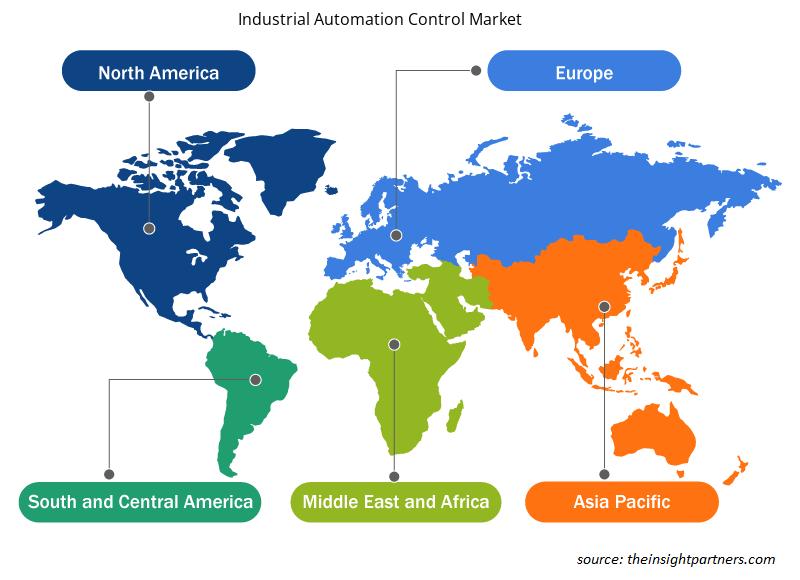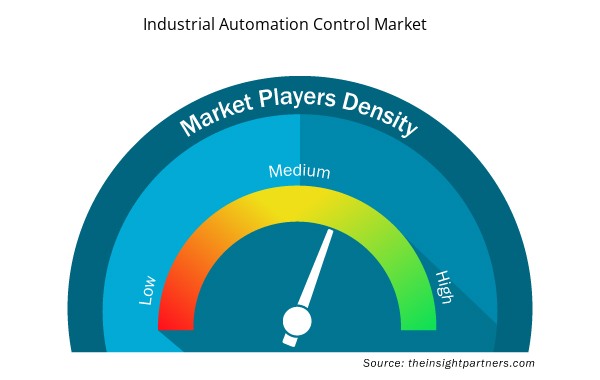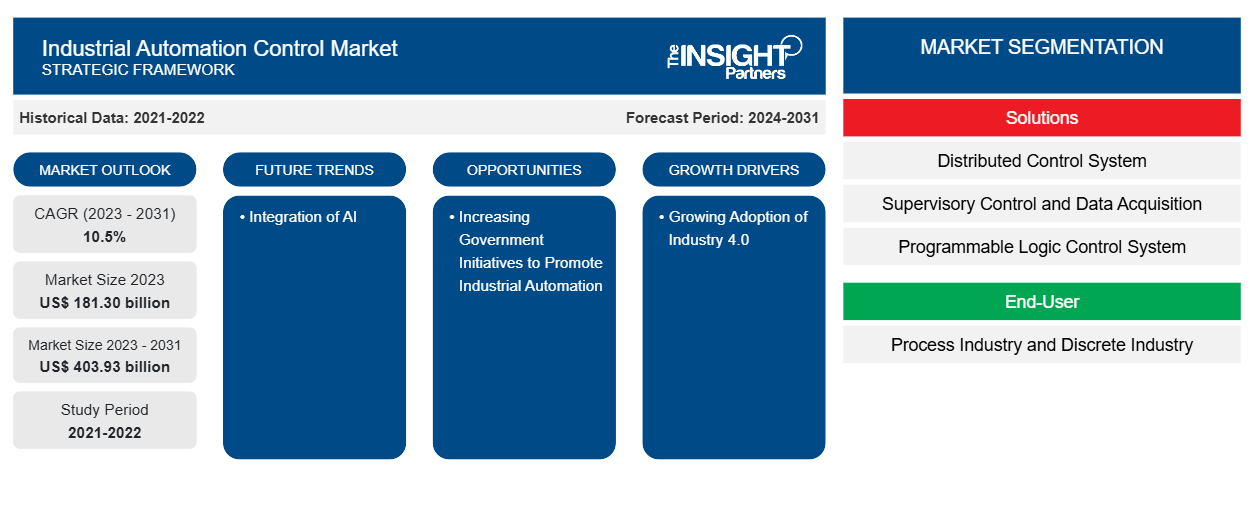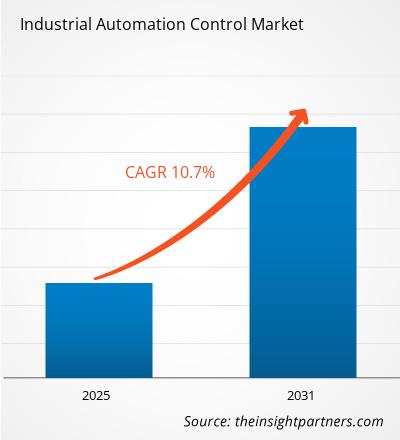産業オートメーション制御市場の規模は、2023年の1,813億米ドルから2031年には4,039億3,000万米ドルに達すると予測されています。市場は2023年から2031年にかけて10.5%のCAGRを記録すると予想されています。ロボット、人工知能、その他の革新的なソリューションなどの最新技術の継続的な統合により、産業部門は大幅に成長しました。
産業オートメーション制御市場分析
自動化システムは、小規模な独立ユニットから、製造現場全体に分散した相互接続された大規模な作業セルのネットワークまで、多岐にわたります。すべてのシステムは特定のアクティビティに合わせて調整されており、コスト削減、品質の向上、オペレーターの安全性、生産性の向上につながります。分析、クラウド、モバイル テクノロジーは、企業が目標をより効率的に達成するのに役立ちます。さらに、産業自動化におけるモノのインターネット (IoT) の台頭により、インターネット接続の利点を取り入れて実装するスマート製造の需要が高まっています。
産業オートメーション制御市場の概要
産業部門は、ロボット工学、人工知能などの高度な技術の継続的な導入により急速に進化しています。さらに、インテリジェントな産業インフラストラクチャを利用することで、自動化により製造と材料処理の作業を迅速化できます。産業界は、生産性の向上と人件費の節約を目指して、産業自動化および制御技術を導入しています。さらに、インダストリー4.0の導入により、製造部門では新しいシステムの採用が急速に進み、ネットワークアーキテクチャが改善されており、市場拡大の大きな見通しが期待されています。
要件に合わせてレポートをカスタマイズする
このレポートの一部、国レベルの分析、Excelデータパックなど、あらゆるレポートを無料でカスタマイズできます。また、スタートアップや大学向けのお得なオファーや割引もご利用いただけます。
- このレポートの主要な市場動向を入手してください。この無料サンプルには、市場動向から見積もりや予測に至るまでのデータ分析が含まれます。
産業オートメーション制御市場の推進要因と機会
インダストリー4.0の採用拡大が市場を有利に導く
インダストリー 4.0 の原則の導入が進むことは、世界の産業オートメーション業界における大きな原動力です。第 4 次産業革命とも呼ばれるインダストリー 4.0 は、従来の生産プロセスにデジタル技術を統合して、効率、生産性、柔軟性を向上させることに重点を置いています。インダストリー 4.0の重要な要素の 1 つは、ロボット工学、強化センサー、クラウド コンピューティングなどの高度なオートメーション技術の広範な導入です。これらの技術により、機械、システム、人間の間でシームレスな通信とコラボレーションが可能になり、より効率的な運用とより優れた意思決定プロセスが実現します。
産業オートメーションを推進する政府の取り組みの強化
産業オートメーションを推進する政府の施策の増加は、世界の産業オートメーション制御業界に大きな展望をもたらしています。世界中の政府は、産業部門における生産性、効率性、競争力を向上させるオートメーションの可能性を急速に認識しつつあります。その結果、企業はオートメーション技術の使用を奨励するためのさまざまな規則やプログラムを開発しています。これらの取り組みは、多くの場合、減税、補助金、助成金、トレーニング プログラムの形をとり、企業がオートメーション技術に投資することを奨励しています。
産業オートメーション制御市場レポートのセグメンテーション分析
産業オートメーション制御市場分析の導出に貢献した主要なセグメントは、ソリューションとエンドユーザーです。
- ソリューションに基づいて、産業オートメーション制御市場は、分散制御システム (DCS)、監視制御およびデータ収集 (SCADA)、プログラマブルロジック制御システム (PLC)、ヒューマンマシンインターフェース (HMI)、製品ライフサイクル管理 (PLM)、その他に分類されます。DCS), supervisory control and data acquisition (SCADA), programmable logic control system (PLC), human machine interface (HMI), product lifecycle management (PLM), others.
- エンドユーザー別に見ると、市場はプロセス産業とディスクリート産業に分類されます。
産業オートメーション制御市場シェアの地域別分析
産業オートメーション制御市場レポートの地理的範囲は、主に北米、アジア太平洋、ヨーロッパ、中東およびアフリカ、南米/中南米の 5 つの地域に分かれています。アジア太平洋地域での急速な拡大は、この地域に重要な業界プレーヤーと成長中の企業が存在するためです。さらに、中国とインドでは、産業プラントを管理するためのより優れたソリューションに対する需要が高まっており、この地域の市場拡大を推進しています。従来の生産設備よりもスマートな生産設備を使用するのが一般的な傾向であり、産業オートメーションの幅広い受け入れに貢献し、地域全体の市場拡大を推進しています。
産業オートメーション制御市場の地域別洞察
予測期間を通じて産業オートメーション制御市場に影響を与える地域的な傾向と要因は、Insight Partners のアナリストによって徹底的に説明されています。このセクションでは、北米、ヨーロッパ、アジア太平洋、中東およびアフリカ、南米および中米にわたる産業オートメーション制御市場のセグメントと地理についても説明します。

- 産業オートメーション制御市場の地域別データを入手
産業オートメーション制御市場レポートの範囲
| レポート属性 | 詳細 |
|---|---|
| 2023年の市場規模 | 1,813億ドル |
| 2031年までの市場規模 | 4,039.3億米ドル |
| 世界のCAGR(2023年~2031年) | 10.5% |
| 履歴データ | 2021-2022 |
| 予測期間 | 2024-2031 |
| 対象セグメント | ソリューション別
|
| 対象地域と国 | 北米
|
| 市場リーダーと主要企業プロフィール |
|
産業オートメーション制御市場のプレーヤー密度:ビジネスダイナミクスへの影響を理解する
産業オートメーション制御市場は、消費者の嗜好の変化、技術の進歩、製品の利点に対する認識の高まりなどの要因により、エンドユーザーの需要が高まり、急速に成長しています。需要が高まるにつれて、企業は提供を拡大し、消費者のニーズを満たすために革新し、新たなトレンドを活用し、市場の成長をさらに促進しています。
市場プレーヤー密度とは、特定の市場または業界内で活動している企業または会社の分布を指します。これは、特定の市場スペースに、その市場規模または総市場価値に対してどれだけの競合相手 (市場プレーヤー) が存在するかを示します。
産業オートメーション制御市場で事業を展開している主要企業は次のとおりです。
- ABB株式会社 Ltd.
- B&Rインダストリアルオートメーション株式会社GmbH
- ボッシュ・レックスロスAGRexroth AG
- ベッコフ オートメーション GmbH & Co KG Automation GmbH & Co KG
- エマーソンエレクトリック社
- ゼネラル・エレクトリック
免責事項:上記の企業は、特定の順序でランク付けされていません。

- 産業オートメーション制御市場のトップキープレーヤーの概要を入手
産業オートメーション制御市場のニュースと最近の動向
産業オートメーション制御市場は、主要な企業出版物、協会データ、データベースなどの一次調査と二次調査後の定性的および定量的データを収集することによって評価されます。市場の動向の一覧は次のとおりです。
- オムロンは、ESG(環境・社会・ガバナンス)経営を重視し始める製造現場におけるカーボンニュートラルに向けた取り組みの高まりに対応したもので、情報制御と安全制御を高度化したオートメーションコントローラー「NXシリーズ NX502」と、EtherNet/IPTMユニットの新製品「NX-EIP201」を2023年4月に発売しました。xEVなど急速に進化するハイテク製品の生産ラインなど。
(出典:オムロン、同社ウェブサイト、2023年)
- 2023年3月、MODEX 2024において、FANUC America Corporationは、FANUCの制御を一般的なモーション制御機器とシームレスに統合できるPMi-A Plus PLC/CNCモーションコントローラを発表しました。このデモンストレーションでは、FANUCの産業オートメーションとコボット製品ラインの組み合わせを実証し、サプライチェーン業界向けの包括的な自動倉庫ソリューションを提供します。
(出典:FANUC America Corporation、企業ウェブサイト、2023年)
産業オートメーション制御市場レポートの対象範囲と成果物
「産業オートメーション制御市場の規模と予測(2021〜2031年)」レポートでは、以下の分野をカバーする市場の詳細な分析を提供しています。
- 対象範囲に含まれるすべての主要市場セグメントの世界、地域、国レベルでの市場規模と予測
- 市場の動向(推進要因、制約、主要な機会など)
- 今後の主な動向
- 詳細なPEST/ポーターの5つの力とSWOT分析
- 主要な市場動向、主要プレーヤー、規制、最近の市場動向を網羅した世界および地域の市場分析
- 市場集中、ヒートマップ分析、主要プレーヤー、最近の動向を網羅した業界の状況と競争分析
- 詳細な企業プロフィール
- 過去2年間の分析、基準年、CAGRによる予測(7年間)
- PEST分析とSWOT分析
- 市場規模価値/数量 - 世界、地域、国
- 業界と競争環境
- Excel データセット


- Machine Condition Monitoring Market
- Aircraft Landing Gear Market
- Bioremediation Technology and Services Market
- Space Situational Awareness (SSA) Market
- Data Center Cooling Market
- Sexual Wellness Market
- Smart Parking Market
- Quantitative Structure-Activity Relationship (QSAR) Market
- Extracellular Matrix Market
- Nitrogenous Fertilizer Market

Report Coverage
Revenue forecast, Company Analysis, Industry landscape, Growth factors, and Trends

Segment Covered
This text is related
to segments covered.

Regional Scope
North America, Europe, Asia Pacific, Middle East & Africa, South & Central America

Country Scope
This text is related
to country scope.
よくある質問
The global industrial automation control market is expected to reach US$ 391.63 billion by 2031.
The key players holding the majority of shares in the global industrial automation control market are ABB Ltd., B&R Industrial Automation GmbH, Bosch Rexroth AG, Beckhoff Automation GmbH & Co KG, and Emerson Electric Co.
The growing adoption of Industry 4.0 is the major factors that propel the global industrial automation control market.
Integration of AI to play a significant role in the global industrial automation control market in the coming years.
The global industrial automation control market was estimated to be US$ 193.22 billion in 2024 and is expected to grow at a CAGR of 10.7% during the forecast period 2023 - 2031.
Trends and growth analysis reports related to Electronics and Semiconductor : READ MORE..
The Insight Partners performs research in 4 major stages: Data Collection & Secondary Research, Primary Research, Data Analysis and Data Triangulation & Final Review.
- Data Collection and Secondary Research:
As a market research and consulting firm operating from a decade, we have published and advised several client across the globe. First step for any study will start with an assessment of currently available data and insights from existing reports. Further, historical and current market information is collected from Investor Presentations, Annual Reports, SEC Filings, etc., and other information related to company’s performance and market positioning are gathered from Paid Databases (Factiva, Hoovers, and Reuters) and various other publications available in public domain.
Several associations trade associates, technical forums, institutes, societies and organization are accessed to gain technical as well as market related insights through their publications such as research papers, blogs and press releases related to the studies are referred to get cues about the market. Further, white papers, journals, magazines, and other news articles published in last 3 years are scrutinized and analyzed to understand the current market trends.
- Primary Research:
The primarily interview analysis comprise of data obtained from industry participants interview and answers to survey questions gathered by in-house primary team.
For primary research, interviews are conducted with industry experts/CEOs/Marketing Managers/VPs/Subject Matter Experts from both demand and supply side to get a 360-degree view of the market. The primary team conducts several interviews based on the complexity of the markets to understand the various market trends and dynamics which makes research more credible and precise.
A typical research interview fulfils the following functions:
- Provides first-hand information on the market size, market trends, growth trends, competitive landscape, and outlook
- Validates and strengthens in-house secondary research findings
- Develops the analysis team’s expertise and market understanding
Primary research involves email interactions and telephone interviews for each market, category, segment, and sub-segment across geographies. The participants who typically take part in such a process include, but are not limited to:
- Industry participants: VPs, business development managers, market intelligence managers and national sales managers
- Outside experts: Valuation experts, research analysts and key opinion leaders specializing in the electronics and semiconductor industry.
Below is the breakup of our primary respondents by company, designation, and region:

Once we receive the confirmation from primary research sources or primary respondents, we finalize the base year market estimation and forecast the data as per the macroeconomic and microeconomic factors assessed during data collection.
- Data Analysis:
Once data is validated through both secondary as well as primary respondents, we finalize the market estimations by hypothesis formulation and factor analysis at regional and country level.
- Macro-Economic Factor Analysis:
We analyse macroeconomic indicators such the gross domestic product (GDP), increase in the demand for goods and services across industries, technological advancement, regional economic growth, governmental policies, the influence of COVID-19, PEST analysis, and other aspects. This analysis aids in setting benchmarks for various nations/regions and approximating market splits. Additionally, the general trend of the aforementioned components aid in determining the market's development possibilities.
- Country Level Data:
Various factors that are especially aligned to the country are taken into account to determine the market size for a certain area and country, including the presence of vendors, such as headquarters and offices, the country's GDP, demand patterns, and industry growth. To comprehend the market dynamics for the nation, a number of growth variables, inhibitors, application areas, and current market trends are researched. The aforementioned elements aid in determining the country's overall market's growth potential.
- Company Profile:
The “Table of Contents” is formulated by listing and analyzing more than 25 - 30 companies operating in the market ecosystem across geographies. However, we profile only 10 companies as a standard practice in our syndicate reports. These 10 companies comprise leading, emerging, and regional players. Nonetheless, our analysis is not restricted to the 10 listed companies, we also analyze other companies present in the market to develop a holistic view and understand the prevailing trends. The “Company Profiles” section in the report covers key facts, business description, products & services, financial information, SWOT analysis, and key developments. The financial information presented is extracted from the annual reports and official documents of the publicly listed companies. Upon collecting the information for the sections of respective companies, we verify them via various primary sources and then compile the data in respective company profiles. The company level information helps us in deriving the base number as well as in forecasting the market size.
- Developing Base Number:
Aggregation of sales statistics (2020-2022) and macro-economic factor, and other secondary and primary research insights are utilized to arrive at base number and related market shares for 2022. The data gaps are identified in this step and relevant market data is analyzed, collected from paid primary interviews or databases. On finalizing the base year market size, forecasts are developed on the basis of macro-economic, industry and market growth factors and company level analysis.
- Data Triangulation and Final Review:
The market findings and base year market size calculations are validated from supply as well as demand side. Demand side validations are based on macro-economic factor analysis and benchmarks for respective regions and countries. In case of supply side validations, revenues of major companies are estimated (in case not available) based on industry benchmark, approximate number of employees, product portfolio, and primary interviews revenues are gathered. Further revenue from target product/service segment is assessed to avoid overshooting of market statistics. In case of heavy deviations between supply and demand side values, all thes steps are repeated to achieve synchronization.
We follow an iterative model, wherein we share our research findings with Subject Matter Experts (SME’s) and Key Opinion Leaders (KOLs) until consensus view of the market is not formulated – this model negates any drastic deviation in the opinions of experts. Only validated and universally acceptable research findings are quoted in our reports.
We have important check points that we use to validate our research findings – which we call – data triangulation, where we validate the information, we generate from secondary sources with primary interviews and then we re-validate with our internal data bases and Subject matter experts. This comprehensive model enables us to deliver high quality, reliable data in shortest possible time.


 このレポートの無料サンプルを入手する
このレポートの無料サンプルを入手する